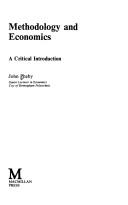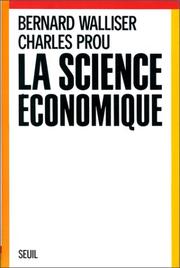| Listing 1 - 10 of 24 | << page >> |
Sort by
|

ISBN: 033338511X Year: 1988 Publisher: Basingstoke Macmillan
Abstract | Keywords | Export | Availability | Bookmark
 Loading...
Loading...Choose an application
- Reference Manager
- EndNote
- RefWorks (Direct export to RefWorks)
Book
ISBN: 9062565573 Year: 1988 Publisher: Amsterdam VU Uitgeverij
Abstract | Keywords | Export | Availability | Bookmark
 Loading...
Loading...Choose an application
- Reference Manager
- EndNote
- RefWorks (Direct export to RefWorks)
Book
ISBN: 0903312964 Year: 1988 Publisher: London Bank of England
Abstract | Keywords | Export | Availability | Bookmark
 Loading...
Loading...Choose an application
- Reference Manager
- EndNote
- RefWorks (Direct export to RefWorks)
Book
ISBN: 0444703624 Year: 1988 Publisher: Amsterdam : Elsevier science publishers,
Abstract | Keywords | Export | Availability | Bookmark
 Loading...
Loading...Choose an application
- Reference Manager
- EndNote
- RefWorks (Direct export to RefWorks)
Mathematical control systems --- Stochastic processes --- Organization theory --- AA / International- internationaal --- 330.3 --- 650 --- Methode in staathuishoudkunde. Statische, dynamische economie. Modellen. Experimental economics. --- Theorieën en grondbeginselen. Management. --- Optimisation mathématique --- Programmation (mathématiques) --- Théorie moderne du portefeuille --- Receherche opérationnelle

ISBN: 202010086X 9782020100861 Year: 1988 Publisher: Paris : Seuil,
Abstract | Keywords | Export | Availability | Bookmark
 Loading...
Loading...Choose an application
- Reference Manager
- EndNote
- RefWorks (Direct export to RefWorks)
Economics --- Economics. --- Analyse économique --- Economic analysis --- Système économique --- economic systems --- Modèle --- Models --- AA / International- internationaal --- 330.00 --- 330.3 --- Economische en sociale theorieën: algemeenheden. --- Methode in staathuishoudkunde. Statische, dynamische economie. Modellen. Experimental economics. --- Economic theory --- Political economy --- Social sciences --- Economic man --- Economische en sociale theorieën: algemeenheden --- Methode in staathuishoudkunde. Statische, dynamische economie. Modellen. Experimental economics
Book
ISBN: 3540189661 3642456413 Year: 1988 Publisher: Berlin Springer
Abstract | Keywords | Export | Availability | Bookmark
 Loading...
Loading...Choose an application
- Reference Manager
- EndNote
- RefWorks (Direct export to RefWorks)
Structural exchange rate modeling has proven extremely difficult during the recent post-1973 float. The disappointment climaxed with the papers of Meese and Rogoff (1983a, 1983b), who showed that a "naive" random walk model distinctly dominated received theoretical models in terms of predictive performance for the major dollar spot rates. One purpose of this monograph is to seek the reasons for this failure by exploring the temporal behavior of seven major dollar exchange rates using nonstructural time-series methods. The Meese-Rogoff finding does not mean that exchange rates evolve as random walks; rather it simply means that the random walk is a better stochastic approximation than any of their other candidate models. In this monograph, we use optimal model specification techniques, including formal unit root tests which allow for trend, and find that all of the exchange rates studied do in fact evolve as random walks or random walks with drift (to a very close approximation). This result is consistent with efficient asset markets, and provides an explanation for the Meese-Rogoff results. Far more subtle forces are at work, however, which lead to interesting econometric problems and have implications for the measurement of exchange rate volatility and moment structure. It is shown that all exchange rates display substantial conditional heteroskedasticity. A particularly reasonable parameterization of this conditional heteroskedasticity, which captures the observed clustering of prediction error variances, is developed in Chapter 2.
International finance --- Business & Economics --- Economic Theory --- AA / International- internationaal --- 330.3 --- 333.450 --- Methode in staathuishoudkunde. Statische, dynamische economie. Modellen. Experimental economics. --- Theorie van het deviezenverkeer. Theorie van de koopkrachtpariteit. --- Methode in staathuishoudkunde. Statische, dynamische economie. Modellen. Experimental economics --- Theorie van het deviezenverkeer. Theorie van de koopkrachtpariteit
Book
ISBN: 0521294371 0521222885 9780521222884 9780521294379 Year: 1988 Publisher: Cambridge : Cambridge University Press,
Abstract | Keywords | Export | Availability | Bookmark
 Loading...
Loading...Choose an application
- Reference Manager
- EndNote
- RefWorks (Direct export to RefWorks)
Methodology of economics --- Economics --- Methodology --- Methodology. --- 330.00 --- 330.3 --- 330.40 --- AA / International- internationaal --- 330.81 --- 330.81 Voorlopers van Adam Smith. Mercantilisme. Colbertisme. Fysiocraten. Kameralisme --(economisch denken) --- Voorlopers van Adam Smith. Mercantilisme. Colbertisme. Fysiocraten. Kameralisme --(economisch denken) --- Economische en sociale theorieën: algemeenheden --- Methode in staathuishoudkunde. Statische, dynamische economie. Modellen. Experimental economics --- Geschiedenis van het economisch en sociaal denken --- Economics - Methodology
Book
ISBN: 2869170289 Year: 1988 Volume: 23 Publisher: Paris Calmann-Lévy
Abstract | Keywords | Export | Availability | Bookmark
 Loading...
Loading...Choose an application
- Reference Manager
- EndNote
- RefWorks (Direct export to RefWorks)
Economics --- Economie politique --- Philosophy --- Philosophie --- AA / International- internationaal --- 305.4 --- 330.2 --- 330.00 --- 330.3 --- Econometrie van de inkomensvorming, de spaarvorming, de kapitaalvorming. Input-output tabellen --- Economische analyse en research. Theorie van de informatie --- Economische en sociale theorieën: algemeenheden --- Methode in staathuishoudkunde. Statische, dynamische economie. Modellen. Experimental economics

ISBN: 2130402836 Year: 1988 Publisher: Paris PUF
Abstract | Keywords | Export | Availability | Bookmark
 Loading...
Loading...Choose an application
- Reference Manager
- EndNote
- RefWorks (Direct export to RefWorks)
National accounts --- National income --- -336.126 <44> --- AA / International- internationaal --- FR / France - Frankrijk --- 339.0 --- 330.3 --- Net national product --- Flow of funds --- Gross national product --- Income --- Accounting --- Algemeenheden. Nationale rekeningen. --- Methode in staathuishoudkunde. Statische, dynamische economie. Modellen. Experimental economics. --- Accounting. --- 336.126 <44> --- National accounting --- National income accounting --- Methode in staathuishoudkunde. Statische, dynamische economie. Modellen. Experimental economics --- Algemeenheden. Nationale rekeningen --- Income accounting --- Social accounting
Book
ISBN: 0333456637 9780333456637 Year: 1988 Publisher: Basingstoke Macmillan
Abstract | Keywords | Export | Availability | Bookmark
 Loading...
Loading...Choose an application
- Reference Manager
- EndNote
- RefWorks (Direct export to RefWorks)
Keynes, John Maynard --- Keynesian economics --- Probabilities --- Keynes, John Maynard, --- AA / International- internationaal --- 330.47 --- 330.3 --- 331.033 --- 303.3 --- Keynes en zijn school. --- Methode in staathuishoudkunde. Statische, dynamische economie. Modellen. Experimental economics. --- Theorie van de investeringen. --- Waarschijnlijkheid. Probabiliteit. Nauwkeurigheid. Residuals: measurement and specification (wiskundige statistiek). --- Keynes en zijn school --- Methode in staathuishoudkunde. Statische, dynamische economie. Modellen. Experimental economics --- Theorie van de investeringen --- Waarschijnlijkheid. Probabiliteit. Nauwkeurigheid. Residuals: measurement and specification (wiskundige statistiek) --- Keynes, John Maynard, - 1883-1946
| Listing 1 - 10 of 24 | << page >> |
Sort by
|

 Search
Search Feedback
Feedback About
About Help
Help News
News